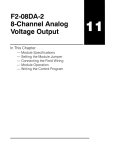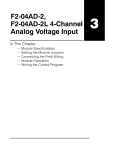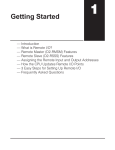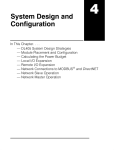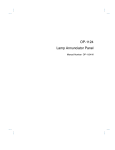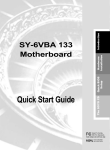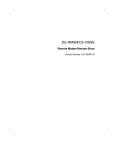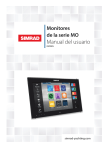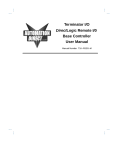Download Chapter 4 - AutomationDirect
Transcript
D2–RMSM Setup Programming ! " ' "" " " $" # ' " # " "# ' %! & # "! ' # "! ' & 14 4–2 D2–RMSM Setup Programming Getting Started with Your Programming D2–RMSM Setup Programming You can write your program using either a handheld programmer or a PC loaded with software such as DirectSOFT. The examples that follow will show you how to do it using DirectSOFT. To get started, enter DirectSOFT and carry out the normal DirectSOFT setup procedures for communicating with your DL205 CPU. If you do not know how to do this, refer to your DirectSOFT Manual. Your DL205 User’s Manual has a very good coverage of the basic commands available and examples of using the commands to write general ladder logic. We will be showing you in this chapter only those commands that pertain to setting up your remote I/O initialization and its successful utilization. First open DirectSOFT from Windows and establish a link with your CPU. Then enter the Edit Mode for programming. You should now be looking at a screen similar to the one shown below: The DirectSOFT window shown above depicts a program that has already been written. Your window, of course, will be empty when you first enter it. The pages that follow will show you how to write each part of your initialization program. D2–RMSM Setup Programming 4–3 Writing Your Remote I/O Setup Step 1: Decide How You Are Going to Call Your Program Is your setup logic going to be in the main program body or is it going to be in a subroutine? A subroutine for your remote I/O setup has an advantage over writing the code into the program’s main body. Some remote I/O setup logic becomes quite lengthy. By putting the setup in a subroutine, you don’t have to scroll through extra logic during routine troubleshooting procedures. We advise you to use a subroutine for your remote I/O initialization. Here’s how: Using the GTS Command for the Setup Logic Note: SP0 is a special relay contact which energizes only on the first scan of the program SP0 DirectSOFT Display D2–RMSM Setup Programming 4–4 D2–RMSM Setup Programming D2–RMSM Setup Programming Step 2: Write the Setup Logic for Each Channel Whether you choose to write the remote I/O setup program as a subroutine or as a part of the main program, the procedure is still the same. You have several things you must do for each channel of remote I/O: S Tell the remote master to initiate setup, and define the auto return to network option. S Tell the remote master the starting V-memory address for inputs and outputs, and the total number of each for the channel. You do this with address pointers and constant data. S Tell the remote master how many input and output points are located in each base. S Tell the remote master to save the parameters in EEPROM (setup is complete). To write the setup logic, we use the CPU instructions described below. If you are not familiar with these instructions, you may want to refer to the DL205 User Manual for more details and examples. The Load instruction is a 16-bit instruction that loads the value (Aaaa), which is either a V-memory location or a 4-digit constant, into the lower 16 bits of the accumulator. The upper 16 bits of the accumulator are set to 0. The Load Address instruction is a 16 bit instruction. It converts any octal value or address to the HEX equivalent value and loads the HEX value into the accumulator. The OUT instruction is a 16 bit instruction that copies the values in the lower 16 bits of the accumulator to a specified V-memory location (Aaaa). The WT instruction writes a block of data (1–128 bytes max.) to an intelligent I/O module from a block of V-memory in the CPU. The function parameters (module base/slot address, number of bytes, and the intelligent I/O module memory address) are loaded into the first and second level of the accumulator stack, and the accumulator by three additional instructions. In the WT instruction, Aaaa specifies the starting V-memory address where the data will be written from in the CPU. You use these instructions to set up the configuration data in a block of V-memory which serves as a buffer. Use WT instructions to store the data to various shared memory locations in the Remote Master module. Use your worksheets to assist you in creating the setup logic. 4–5 D2–RMSM Setup Programming Examples for Typical Configurations Example 1: Addressing using X and Y memory To illustrate the setup program for a system using X’s as remote inputs and Y’s as remote outputs, we will use the example system from Chapter 2, shown here with a completed Channel Configuration Worksheet. The first block of logic tells the remote master to initiate the setup, and to enable the Auto Return to Network option. To find the D2–RMSM shared memory addresses used in the setup program, refer to the Shared Memory Table at the end of this chapter. Write Configuration Byte Channel Configuration Sheet Main Base with Master PS CPU 16 16 16 16 I I O O D2–RMSM Remote Master Module 4 (1–7)_ Master Slot Address _____ Protocol Selected _________ RM–NET (RM–NET or SM–NET) Circle one selection for each parameter (selections for each protocol are shown) RM–NET Configuration Parameter SM–NET Baud Rate (in KBaud), determined by required distance to last slave X0-X17 X20-X37 Y0-Y17Y20-Y37 V40400 V40401 V40500 V40501 Operator Interface N/A Auto Return to Network (either protocol) YES 96 Total No. Inputs ________ 16 16 16 16 16 I I O O O Slave Station 2nd Remote 8 8 8 16 (8) I I O O O X100-107 X110-117 Y120-127 Y130-147 SPACE V40404 V40505 V40505+6 3rd Remote PS 19.2 38.4 307.2 614.4 YES 153.6 NO NO 16 16 16 12 12 I I I O O X120-137 X140-157X160-177Y160-177Y200-217 V40405 V40406 V40407 V40507 V40510 SP0 LD K87 OUT LD K1 LDA WT No. Inputs No. Outputs N/A N/A 32 16 48 32 48 32 No. Inputs No. Outputs 16 17 18 19 20 21 22 23 24 25 26 27 28 29 30 31 Bits 0,1,2 ON initiates the setup Bit 7 defines Auto Return to Network (ON=Yes) V2000 Choose a word of available V memory to use as a buffer K04 LD 112 Total No. Outputs ________ Slave Station Master address: High byte is rack (0), low byte is slot (4) Number of bytes to write to shared memory (1 byte) O176 Shared memory address of configuration byte V2000 Write value in lower byte of V2000 to Master memory D2–RMSM Setup Programming 0 1 2 3 4 5 6 7 8 9 10 11 12 13 14 15 X40-X57 X60-X77 Y40-Y57 Y60-Y77 Y100-Y117 V40402 V40403 V40502 V40503 V40504 PS 38.4 40402 Starting Output V Memory Address: V _______ 40502 Starting Input V Memory Address: V_______ 1st Remote PS 19.2 4–6 D2–RMSM Setup Programming This block of logic tells the remote master the starting V-memory addresses for the inputs and outputs, and the total number of each for the channel. Use the LD, LDA, and OUT commands to load the starting addresses and point totals into temporary memory, then write the values to the master’s shared memory. The Quick Reference Table shows the correct shared memory addresses in octal. The LDA instruction uses octal numbers, designated by the capital O in front of the number. Write Input and Output Pointers, and Input and Output Ranges for Channel SP0 LDA O40402 Input V–memory OUT V2001 V–memory buffer LDA O40502 Output V–memory OUT V2002 Channel Configuration Worksheet D2–RMSM Remote Master Module 4 (1–7)_ Master Slot Address _____ Protocol Selected _________ RM–NET (RM–NET or SM–NET) K04 Circle one selection for each parameter (selections for each protocol are shown) RM–NET Configuration Parameter SM–NET LD Baud Rate (in KBaud), determined by required distance to last slave LDA 19.2 Operator Interface 38.4 N/A Auto Return to Network (either protocol) YES NO 19.2 38.4 307.2 614.4 YES NO YES NO 153.6 40402 Starting Output V Memory Address: V _____ 40502 Starting Input V Memory Address: V______ 96 Total Inputs ________ Slave Station D2–RMSM Setup Programming LD 0 1 2 3 4 5 6 7 8 9 10 11 12 13 14 15 SP0 O00 V2001 LD K96 112 Total Outputs ________ Slave No. of Inputs No. of Outputs Station N/A WT K4 32 16 N/A 48 32 48 32 OUT No. of Inputs No. of Outputs Number of bytes Shared Memory address Write Master memory Input points total K112 Output points total OUT LD V2012 V–memory buffer K04 LD K4 LDA WT Master module address V2011 V–memory buffer LD 16 17 18 19 20 21 22 23 24 25 26 27 28 29 30 31 V–memory buffer O124 V2011 Master module address Number of bytes Shared Memory address Write Master memory Quick Reference Table of Shared Memory Addresses D2–RMSM Setup Initiation Byte 176 Setup Complete Byte 177 Output Number of Number of Slave Input Address Address Input Pts Output Pts ALL 000 002 124 126 1 N/A N/A 004 006 2 N/A N/A 010 012 3 N/A N/A 014 016 4 N/A N/A 020 022 5 N/A N/A 024 026 6 N/A N/A 030 032 7 N/A N/A 034 036 4–7 D2–RMSM Setup Programming This block of logic tells the remote master how many input and output points are located in each base. Each group of four instructions loads the I/O ranges for a slave into temporary memory, the values for which are retrieved from the Remote Slave Worksheets. The WT instruction stores the entire buffer area to the master’s shared memory. The Quick Reference Table shows the correct shared memory addresses in octal. Write Input and Output Ranges for each Slave SP0 LD K32 OUT LD LD LD V–memory buffer Baud Rate (in KBaud), determined by required distance to last slave LD V2004 V–memory buffer V2005 V–memory buffer V2006 V–memory buffer K48 OUT LD Slave 3 Input points V2007 V–memory buffer 32 Slave 3 Output points OUT LD LD Operator Interface 38.4 N/A Auto Return to Network (either protocol) YES NO 19.2 38.4 307.2 614.4 YES NO YES NO 153.6 V2010 V–memory buffer K04 Master module address K12 Number of bytes O04 Shared Memory address V2003 96 Total Inputs ________ Slave Station 0 1 2 3 4 5 6 7 8 9 10 11 12 13 14 15 No. of Inputs No. of Outputs N/A 32 16 N/A 48 32 48 32 No. of Inputs No. of Outputs 16 17 18 19 20 21 22 23 24 25 26 27 28 29 30 31 Quick Reference Table of Shared Memory Addresses Write Master memory The last four instructions write the slaves’ range data to the Master’s shared memory. Address 004 is the start of the slave data; the byte length of 12 writes 6 consecutive words of data. 112 Total Outputs ________ Slave Station D2–RMSM Configuration Byte 176 Setup Complete Byte 177 Output Number of Number of Slave Input Address Address Input Pts Output Pts ALL 000 002 124 126 1 N/A N/A 004 006 2 N/A N/A 010 012 3 N/A N/A 014 016 4 N/A N/A 020 022 5 N/A N/A 024 026 6 N/A N/A 030 032 7 N/A N/A 034 036 D2–RMSM Setup Programming LDA 19.2 40402 Starting Output V Memory Address: V _____ 40502 Starting Input V Memory Address: V______ K32 Slave 2 Output points OUT WT Circle one selection for each parameter (selections for each protocol are shown) RM–NET Configuration Parameter SM–NET K16 Slave 2 Input points OUT D2–RMSM Remote Master Module 4 (1–7)_ Master Slot Address _____ Protocol Selected _________ RM–NET (RM–NET or SM–NET) Slave 1 Input points K48 Slave 1 Output points OUT SP0 V2003 Channel Configuration Worksheet 4–8 D2–RMSM Setup Programming Write Setup Complete (store channel parameters to EEPROM) KC1 V2013 K04 K1 Constant that commands master to store parameters to EEPROM V memory buffer Master module address Number of bytes O177 Shared Memory address of Setup Complete Byte V2013 Write Master memory We can now complete the setup program.This last block of logic tells the remote master to save the parameters in EEPROM (setup is complete). The setup complete logic structure is the same for any channel using a D2–RMSM as a master. D2–RMSM Setup Programming The completed setup program for this example is shown on the next page. 4–9 D2–RMSM Setup Programming Completed Setup Program for X and Y Addressing RLL Program Go to remote I/O subroutine Main Program Body from bottom of previous column Remote I/O Subroutine Initiate Setup Bits 0,1,2=7 initiates setup Bit 7=1 sets Auto Return to Network Store in temporary memory Rack/Slot Address of Master Number of bytes to write Store to Shared Memory Address From Table Below Store in temporary memory Rack/Slot Address of Master Number of bytes to write Address From Table Below Set up Complete Code Store to Shared Memory Store in temporary memory number of output points Write slave range data C1 means store settings Store in temporary memory Rack/Slot Address of Master Number of bytes to write Address From Table Below Write Setup Complete Byte Quick Reference Table of Shared Memory Addresses Store in temporary memory D2–RMSM Setup Initiation Byte 176 Setup Complete Byte 177 Store in temporary memory Output Number of Number of Slave Input Address Address Input Pts Output Pts ALL 000 002 124 126 1 N/A N/A 004 006 Write input and output pointers 2 N/A N/A 010 012 number of input points 3 N/A N/A 014 016 4 N/A N/A 020 022 5 N/A N/A 024 026 6 N/A N/A 030 032 7 N/A N/A 034 036 Store in temporary memory number of output points Starting input address (X040) Address From Table Below Store in temporary memory number of input points Write total range data Number of bytes to write Store in temporary memory number of output points Store in temporary memory Rack/Slot Address of Master to top of next column Set up 3rd Remote Input and Output Ranges Set up 1st Remote Input and Output Ranges Starting output address (Y040) Store in temporary memory D2–RMSM Setup Programming Store to Shared Memory total number of output points Number of bytes to write Set up Input and Output Pointers Store in temporary memory Rack/Slot Address of Master Set up 2nd Remote Input and Output Ranges total number of input points Store to Shared Memory Address From Table below Write Address Config. data Set up Channel Input and Output Ranges number of input points Store to Shared Memory first scan relay 4–10 D2–RMSM Setup Programming Example 2: Addressing using Control Relay Memory In certain applications, you may need to address remote I/O as a memory type other than real inputs (X type) and/or real outputs (Y type). If you have used all available I/O references in the system, and need to add remote I/O, you can use the control relay (C type) memory as the I/O references. You may allocate C memory for inputs, outputs, or both. To write a setup program with this option, we will use the system from Example 1. This example illustrates the difference in defining the pointer addresses; we have assigned both inputs and outputs to control relay references. Retrieve the V–memory addresses for the input and output control relays from the Reserved Memory Table in Appendix B. The rest of the setup logic is identical to Example 1. Write Configuration Byte Channel Configuration Worksheet D2–RMSM Remote Master Module 4 (1–7)_ Master Slot Address _____ Protocol Selected _________ RM–NET (RM–NET or SM–NET) Main Base with Master PS CPU 16 16 16 16 I I O O Circle one selection for each parameter (selections for each protocol are shown) RM–NET Configuration Parameter SM–NET Baud Rate (in KBaud), determined by required distance to last slave 19.2 Operator Interface X0-X17 X20-X37 Y0-Y17Y20-Y37 V40400 V40401 V40500 V40501 38.4 N/A Auto Return to Network (either protocol) YES NO 19.2 38.4 307.2 614.4 YES NO YES NO 153.6 40600 Starting Output V Memory Address: V _____ 40610 Starting Input V Memory Address: V______ 96 Total Inputs ________ 1st Remote PS 16 I 16 I 16 O 16 O 16 O C0-C17 C20-C37 C200-217 C220-237 C240-257 V40600 V40601 V40610 V40611 V40612 2nd Remote PS 8 8 8 16 (8) I I O O O D2–RMSM Setup Programming C40-C47 C50-C57 C260-267 C270-307 SPACE V40602 V40613 V40613+14 3rd Remote PS 16 16 16 12 12 I I I O O Slave Station 112 Total Outputs ________ No. of Inputs No. of Outputs N/A 0 1 2 3 4 5 6 7 8 9 10 11 12 13 14 15 32 16 N/A 48 32 48 32 Slave Station No. of Inputs No. of Outputs 16 17 18 19 20 21 22 23 24 25 26 27 28 29 30 31 C60-C77 C100-117 C120-137 C320-337 C340-357 V40603 V40604 V40605 V40615 V40616 SP0 LD K87 Bits 0,1,2 = ON initiates setup Bit 7 defines Auto Return to Network (ON=Yes) OUT V2000 Choose a word of available V–memory to use as a buffer LD LD LDA WT K04 K1 Master address: High byte is rack (0), low byte is slot (4) Number of bytes to write to shared memory (1 byte) O176 Shared memory address of configuration byte V2000 Write value in lower byte of V2000 to Master memory D2–RMSM Setup Programming 4–11 This block of logic tells the remote master the starting V-memory addresses for the inputs and outputs, and the total number of each for the channel. The V-memory addresses correspond to C0 (for inputs) and C200 (for outputs). Load the starting addresses and point totals into temporary memory, then write the values to the master’s shared memory. The Quick Reference Table shows the correct shared memory addresses in octal. SP0 LDA O40600 Input V–memory Write Input and Output Pointers, and Input and Output Ranges for Channel OUT V2001 V–memory buffer LDA O40610 Output V–memory OUT Channel Configuration Worksheet D2–RMSM Remote Master Module 4 (1–7)_ Master Slot Address _____ Protocol Selected _________ RM–NET (RM–NET or SM–NET) LD K04 Circle one selection for each parameter (selections for each protocol are shown) RM–NET Configuration Parameter SM–NET LD Baud Rate (in KBaud), determined by required distance to last slave LDA 19.2 Operator Interface 38.4 N/A Auto Return to Network (either protocol) YES NO 19.2 38.4 307.2 614.4 YES NO YES NO 153.6 40600 Starting Output V Memory Address: V _____ 40610 Starting Input V Memory Address: V______ 96 Total Inputs ________ Slave Station 32 16 N/A 48 32 48 32 O00 V2001 LD 112 Total Outputs ________ Slave No. of Inputs No. of Outputs Station N/A SP0 K4 K96 OUT No. of Inputs No. of Outputs Shared Memory address Write Master memory Input points total K112 Output points total OUT LD V2012 V–memory buffer K04 LD K4 LDA WT Number of bytes V2011 V–memory buffer LD 16 17 18 19 20 21 22 23 24 25 26 27 28 29 30 31 Master module address Master module address Number of bytes O124 Shared Memory address V2011 Write Master memory Quick Reference Table of Shared Memory Addresses D2–RMSM Setup Initiation Byte 176 Setup Complete Byte 177 Output Number of Number of Slave Input Address Address Input Pts Output Pts ALL 000 002 124 126 1 N/A N/A 004 006 2 N/A N/A 010 012 3 N/A N/A 014 016 4 N/A N/A 020 022 5 N/A N/A 024 026 6 N/A N/A 030 032 7 N/A N/A 034 036 Since the logic for the slave range data and setup complete is identical to Example 1, we will now show the completed setup program on the next page. D2–RMSM Setup Programming 0 1 2 3 4 5 6 7 8 9 10 11 12 13 14 15 WT V2002 V–memory buffer 4–12 D2–RMSM Setup Programming Completed Setup Program for Control Relay Addressing RLL Program Go to remote I/O subroutine Main Program Body from bottom of previous column Remote I/O Subroutine Set up 2nd Remote Input and Output Ranges Initiate Setup Bits 0,1,2=7 initiates setup Bit 7=1 sets Auto Return to Network Store in temporary memory Rack/Slot Address of Master Number of bytes to write total number of input points Store to Shared Memory D2–RMSM Setup Programming Store to Shared Memory Set up 1st Remote Input and Output Ranges Store in temporary memory Store to Shared Memory Store in temporary memory number of output points Rack/Slot Address of Master Number of bytes to write Address From Table Below Number of bytes to write Address From Table Below Store in temporary memory Rack/Slot Address of Master Store to Shared Memory Write slave range data C1 means store settings Set up Complete Code Store in temporary memory Address From Table Below Write Setup Complete Byte Write total range data Store in temporary memory D2–RMSM Rack/Slot Address of Master Setup Initiation Byte 176 Number of bytes to write Setup Complete Byte 177 Write input and output pointers Store in temporary memory number of output points Quick Reference Table of Shared Memory Addresses Starting output address (C200) number of input points Store in temporary memory Address From Table Below to top of next column number of input points memory addresses for control relays as inputs and outputs Store in temporary memory Starting input address (C0) Set up Input and Output Pointers total number of output points Number of bytes to write Store in temporary memory Rack/Slot Address of Master Address From Table below Set up 3rd Remote Input and Output Ranges Write Address Config. data Set up Channel Input and Output Ranges Store in temporary memory number of output points Store to Shared Memory first scan relay number of input points Store in temporary memory Output Number of Number of Slave Input Address Address Input Pts Output Pts ALL 000 002 124 126 1 N/A N/A 004 006 2 N/A N/A 010 012 3 N/A N/A 014 016 4 N/A N/A 020 022 5 N/A N/A 024 026 6 N/A N/A 030 032 7 N/A N/A 034 036 D2–RMSM Setup Programming 4–13 Changing Configurations If you have stored a configuration to the D2–RMSM via the setup program and need to change it, follow these guidelines to ensure the module accepts the new configuration: 1. Change the constants in the setup program that are affected by the new system configuration. For example, if you add an I/O module to a remote slave unit, you must change the input or output range for that slave, as well as the range total for the channel. If the new range totals do not match the sum of the individual slave ranges, the D2–RMSM will not accept the new configuration. It will retain the old configuration, and give you an I/O error. 2. If you are removing a slave from the channel, you must change the logic of the setup program to clear that slave’s range data in the D2–RMSM shared memory. Otherwise it will still see the old data from the previous configuration. For example, if you remove the third slave from our example system, you would load a constant of zero into the slave’s input and output range data, located at buffer memory addresses V2007 and V2010. If removing I/O, remember to reduce the total I/O range values also. 3. After you have modified the setup program, cycle CPU power, or transition from the STOP to RUN mode to execute the new setup logic. This is necessary if the setup logic executes on the first CPU scan. D2–RMSM Setup Programming 4–14 D2–RMSM Setup Programming Shared Memory Table for D2–RMSM Remote Master OCTAL ADDRESS FUNCTION (Slaves 1–15) FUNCTION (Slaves 16–31) # Bytes D2–RMSM Setup Programming For memory addresses 000 to 077, the user’s setup program must store the correct values into these locations. 000 Starting V–memory address for inputs on the channel (in octal) Number of input points for Slave 16 2 002 Starting V–memory address for outputs on the channel (in octal) Number of output points for Slave 16 2 004 Number of input points for Slave 1 Number of input points for Slave 17 2 006 Number of output points for Slave 1 Number of output points for Slave 17 2 010 Number of input points for Slave 2 Number of input points for Slave 18 2 012 Number of output points for Slave 2 Number of output points for Slave 18 2 014 Number of input points for Slave 3 Number of input points for Slave 19 2 016 Number of output points for Slave 3 Number of output points for Slave 19 2 020 Number of input points for Slave 4 Number of input points for Slave 20 2 022 Number of output points for Slave 4 Number of output points for Slave 20 2 024 Number of input points for Slave 5 Number of input points for Slave 21 2 026 Number of output points for Slave 5 Number of output points for Slave 21 2 030 Number of input points for Slave 6 Number of input points for Slave 22 2 032 Number of output points for Slave 6 Number of output points for Slave 22 2 034 Number of input points for Slave 7 Number of input points for Slave 23 2 036 Number of output points for Slave 7 Number of output points for Slave 23 2 040 Number of input points for Slave 8 Number of input points for Slave 24 2 042 Number of output points for Slave 8 Number of output points for Slave 24 2 044 Number of input points for Slave 9 Number of input points for Slave 25 2 046 Number of output points for Slave 9 Number of output points for Slave 25 2 050 Number of input points for Slave 10 Number of input points for Slave 26 2 052 Number of output points for Slave 10 Number of output points for Slave 26 2 054 Number of input points for Slave 11 Number of input points for Slave 27 2 056 Number of output points for Slave 11 Number of output points for Slave 27 2 060 Number of input points for Slave 12 Number of input points for Slave 28 2 062 Number of output points for Slave 12 Number of output points for Slave 28 2 064 Number of input points for Slave 13 Number of input points for Slave 29 2 066 Number of output points for Slave 13 Number of output points for Slave 29 2 070 Number of input points for Slave 14 Number of input points for Slave 30 2 072 Number of output points for Slave 14 Number of output points for Slave 30 2 074 Number of input points for Slave 15 Number of input points for Slave 31 2 076 Number of output points for Slave 15 Number of output points for Slave 31 2 D2–RMSM Setup Programming OCTAL ADDRESS FUNCTION DETAIL 4–15 # Bytes 18 100 – 121 Reserved 122 Status of Rotary Switches on module – Read Only Data is 00 to 1F hex, representing the address of the module set by the rotary switches. 1 123 Status of DIP Switches on module – Read Only Bit status represents the setting of each switch on the module’s DIP Switch , which sets configuration parameters. 0=OFF, 1=ON. 1 Bit 0 SW1 status Bit 1 SW2 status Bit 2 SW3 status Bit 3 SW4 status Bit 4 SW5 status Bit 5 SW6 status Bit 6 SW7 status Bit 7 SW8 status 124 Number of input points committed to the entire channel User’s setup program stores the correct BCD value to this memory location. 2 126 Number of output points committed to the entire channel User’s setup program stores the correct BCD value to this memory location. 2 D2–RMSM Setup Programming 4–16 D2–RMSM Setup Programming OCTAL ADDRESS 130 – 131 FUNCTION DETAIL Communication stop mode selection (com- In communication stop mode, the master munication stops when any specified slave stops updating the entire channel when a fails) communication error occurs with any specified slave station. To select this mode for each slave, turn ON the corresponding bit of the shared memory shown below. Address 130 Bit 0 D2–RMSM Setup Programming Bit 1 Bit 2 Bit 3 Bit 4 Bit 5 Bit 6 Bit 7 Bit 8 Bit 9 Bit 10 Bit 11 Bit 12 Bit 13 Bit 14 Bit 15 Address 131 Entire channel Slave 16 stops when any slave fails Slave 1 Slave 17 Slave 2 Slave 18 Slave 3 Slave 19 Slave 4 Slave 20 Slave 5 Slave 21 Slave 6 Slave 22 Slave 7 Slave 23 Slave 8 Slave 24 Slave 9 Slave 25 Slave 10 Slave 26 Slave 11 Slave 27 Slave 12 Slave 28 Slave 13 Slave 29 Slave 14 Slave 30 Slave 15 Slave 31 # Bytes 2 D2–RMSM Setup Programming OCTAL ADDRESS 132 – 133 FUNCTION Slave removal mode selection (communication stops to only the slave(s) with a communication error) DETAIL # Bytes In slave removal mode, the master stops updating only the slave(s) with a communication error. It continues updating the I/O for the other slaves on the channel. To select this mode for each slave, turn ON the corresponding bit of the shared memory shown below. 2 Bit 0 Bit 1 Bit 2 Bit 3 Bit 4 Bit 5 Bit 6 Bit 7 Bit 8 Bit 9 Bit 10 Bit 11 Bit 12 Bit 13 Bit 14 Bit 15 Communication hold or resume mode 135 – 137 Reserved 140 Network Error Flags – Read Only Address 132 Address 133 Not used Slave 1 Slave 2 Slave 3 Slave 4 Slave 5 Slave 6 Slave 7 Slave 8 Slave 9 Slave 10 Slave 11 Slave 12 Slave 13 Slave 14 Slave 15 Slave 16 Slave 17 Slave 18 Slave 19 Slave 20 Slave 21 Slave 22 Slave 23 Slave 24 Slave 25 Slave 26 Slave 27 Slave 28 Slave 29 Slave 30 Slave 31 The program can cause the communications on a channel to stop by setting the first bit in this byte ON. After communication stops, only a mode transition of the CPU (from STOP to RUN) will restart the communications. The bit is not cleared automatically, so if using this mode, the user program should clear this byte on the first scan. 1 3 Bit status represents network errors detected by the D2–RMSM. 0=OK, 1=ERROR Bit 0 Configuration Error (see Address 142 for details) Bit 1 Communication Error (see Address 144 for details) Bit 2 Diagnostics Error (see Address 150 for details) 2 D2–RMSM Setup Programming 134 4–17 4–18 D2–RMSM Setup Programming OCTAL ADDRESS D2–RMSM Setup Programming 142 FUNCTION Configuration Error Code – Read Only DETAIL Error code in BCD 20 Total inputs exceeds 512 21 Total outputs exceeds 512 24 I/O address out of I/O range 25 I/O address allocated to bad range 29 A slave has more than 512 points 70 Discrepancy between current configuration and old one 71 A module is in the wrong slot 72 Slave configuration is different from old one 73 Different slave is there # Bytes 1 143 Station Number of Configuration Error – Read Only Station number in BCD 1 144 Communication Error Code – Read Only Error code in BCD 1 01 slave does not respond 02 wrong I/O information 03 I/O update error : CRC check error 145 Station Number of Communication Error Code – Read Only Station number in BCD 1 146 Communication Error Counter – Read Only Number of communication errors detected since CPU went into RUN mode, in BCD 2 150 Diagnostics Error Code Error code in BCD 2 152 Reserved 153 Station number of Diagnostics error – Read Only 0201 Terminal block removed 0202 module not present 0203 Blown fuse 0206 Low battery voltage 0226 Power capacity exceeded 1 Station number in BCD 1 D2–RMSM Setup Programming OCTAL ADDRESS FUNCTION DETAIL 4–19 # Bytes 4 154 – 157 Reserved 160 Current bus scan time – Read Only BCD value of current bus scan, in msec 2 162 Bus scan time upper limit User can store BCD value of bus scan upper limit, in msec. Default is 100 msec. 2 164 Shortest bus scan time – Read Only BCD value of shortest bus scan detected since CPU went into RUN mode, in msec 2 166 Longest bus scan time – Read Only BCD value of longest bus scan detected since CPU went into RUN mode, in msec 2 170 Bus scan counter – Read Only BCD value of number of bus scans detected since CPU went into RUN mode 2 172 Overlimit Bus scan counter – Read Only BCD value of number of bus scans which have exceeded the scan time upper limit 2 174 – 175 Reserved 176 Setup Initiation Byte (includes Auto Return to Network) 2 User’s setup program stores the correct bit pattern to this memory location to configure the following modes: 1 Bits 0,1, and 2 must be ON to initiate setup of remote slave addressing Bit 7 Copy Configuration to EEPROM ( Setup Complete) 1 C1 – Signifies that setup is complete. Hint: This should be the last function of your setup program. 200 – 374 Reserved 125 D2–RMSM Setup Programming 177 ON=Specifies that offline slaves can return to the network without cycling CPU User’s setup program stores a BCD value to this location to log the parameters stored by the setup program to the Master’s EEPROM. 4–20 D2–RMSM Setup Programming OCTAL ADDRESS 375 D2–RMSM Setup Programming 376 – 377 FUNCTION Slave Page Selection Reserved DETAIL # Bytes User’s setup program stores a BCD value to this location to select the page of slave parameters for setup programming: 1 81 Slaves 1–15 82 Slaves 16–31 2 D2–RMSM Setup Programming 4–21 Quick Reference Table of Shared Memory Addresses D2–RMSM Setup Initiation Byte 176 Setup Complete Byte 177 Slave Output Points 002 N/A N/A N/A N/A N/A N/A N/A N/A N/A N/A N/A N/A N/A N/A N/A 124 004 010 014 020 024 030 034 040 044 050 054 060 064 070 074 126 006 012 016 022 026 032 036 042 046 052 056 062 066 072 076 N/A N/A N/A N/A N/A N/A N/A N/A N/A N/A N/A N/A N/A N/A N/A N/A 000 004 010 014 020 024 030 034 040 044 050 054 060 064 070 074 002 006 012 016 022 026 032 036 042 046 052 056 062 066 072 076 Output Address ALL 000 1 N/A 2 N/A 3 N/A 4 N/A 5 N/A 6 N/A 7 N/A 8 N/A 9 N/A 10 N/A 11 N/A 12 N/A 13 N/A 14 N/A 15 N/A 2nd page of slave range data N/A N/A N/A N/A N/A N/A N/A N/A N/A N/A N/A N/A N/A N/A N/A N/A Number of D2–RMSM Setup Programming 16 17 18 19 20 21 22 23 24 25 26 27 28 29 30 31 Address Number of Input Points Input























